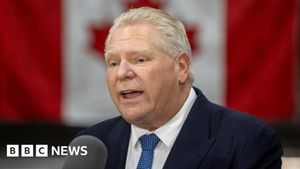The recent announcement by President Donald Trump to impose sweeping tariffs on imports from Canada, Mexico, and China has raised significant concerns about the potential fallout, not only for U.S. relations with its northern and southern neighbors but also for American consumers.
On Saturday, Trump signed executive orders establishing tariffs set at 25% for goods coming from Canada and Mexico and 10% for Chinese imports. This move, which many see as partially fulfilling campaign promises, has already sent ripples through international stock markets and supply chains.
Importantly, these tariffs have been framed by Trump as measures to curb immigration and drug trafficking. He stated, “It is my duty as president to assure the safety of all,” justifying the economic penalties as necessary to pressure neighboring governments to act on these fronts. The tariffs were initially set to take immediate effect, raising concerns about rising costs for U.S. consumers.
Reflecting on these developments, economists are sounding alarm bells about the potential for increased prices. The Budget Lab at Yale University estimates the average American household could see its purchasing power decrease by about $1,200 annually as these tariffs take hold. Similarly, the Tax Foundation predicts households may face around $830 more in costs this year alone. With inflation already under scrutiny, Trump’s tariffs may add to the 2.9% annual inflation rate reported recently, pushing it higher.
Trump’s tariffs target some of the largest sectors of U.S. imports, including natural gas and lumber from Canada, automotive parts from Mexico, and electronics from China. This diverse assortment indicates Trump's strategy aims to exert pressure across many industries, seeking leverage for broader trade negotiations.
Shortly after the announcement, Canadian Prime Minister Justin Trudeau and Mexican President Claudia Sheinbaum swiftly condemned the tariffs, threatening retaliation. Trudeau declared he would impose matching tariffs on approximately $155 billion worth of U.S. imports, urging Canadians to “choose Canadian products” as part of the impending economic battle.
Similarly, Mexican President Sheinbaum initially deemed the tariffs as slanderous and irresponsible, promising to enact countermeasures, including the introduction of tariffs on U.S. goods and ceasing imports of American products like whiskey and avocados. These retaliatory actions have raised eyebrows about how the impacted goods could affect American consumers who enjoy Canadian whiskey and Mexican avocados.
Industry experts have outlined tangible consequences facing consumers for certain goods. For example, economists warn car prices might surge by approximately $3,000 due to higher import taxes levied on parts crossing North American borders multiple times before vehicles are assembled. proposed increases even extend to food items; avocados, popular among consumers, could see significant price hikes as tariffs swell production costs. Grocery prices overall may rise when firms hike prices to cope with additional tariffs.
Adding complexity to this situation is the uncertainty it creates for U.S. businesses reliant on cross-border trade, many of which have expressed concerns about potential disruptions. Some already report difficulty managing supply chain reliability as they adapt to the unpredictability of tariffs. Gregory Daco from EY remarked, “Markets don’t like tariffs. They recognize they’re taxes, and they see the price of oil going higher and increased prices at the supermarkets.”
The stock market is also reacting to the tariffs, showcasing significant volatility. Early trading saw the Dow Jones Industrial Average plunge over 600 points, only to recover somewhat after news broke of the temporary pause of tariffs against Mexico. The president's perception of the pause as positivity reflects his strategy of maintaining transactional negotiation styles with foreign leaders. Mingling economic terms with border security, he promised future talks with Trudeau and Sheinbaum.
Nevertheless, the threatened tariffs have set off chain reactions across global stock platforms, leading to wider conversations surrounding international trade relations. With the EU also preparing for potential retaliation against U.S. products, it appears increasingly likely contracts will unravel, eliciting tension reminiscent of previous trade conflicts.
Long-term consequences may compound as consumer spending tightens, and the costs of living increase. Even products labeled “Made in the U.S.A.” may still experience price surges due to foreign components, leaving American households to adjust their purchasing decisions. The ripple effects of these tariffs are expected to compound; industries could reorganize supply chains, raising consumer costs even more over time.
Critical voices like former Canadian finance minister Chrystia Freeland have emerged, adamantly opposing the tariffs, calling them “unjustified and pointless.” She maintains less than 1% of fentanyl entering the U.S. originates from Canada, challenging the rationale for such heavy-handed trade measures based on drug interdiction efforts. Freeland asserts the need for stronger diplomatic responses rather than punitive tariffs to resolve bilateral trade disputes.
Overall, the political and economic stakes surrounding Trump’s tariff imposition are palpably high. Discussions have already started signaling the potential for another trade war, one where consumers may bear the brunt of high prices and diminished product availability. Going forth, the broader question remains: will these tariffs fulfill their goal of rectifying trade imbalances, or will they become another notch on the belt of ineffective trade strategies?



